Imagine knowing user actions before they even occur. Predicting users’ needs, personalizing their experiences, and staying ahead of the curve can be done using predictive analytics.
Companies have access to big data, but what separates the winners is the ability to turn these data into actionable insights, and this is where predictive analytics comes in. Predictive analytics is expected to reach $67.86 billion by 2032, enabling a broader set of companies to have access to predicting analytics without necessarily having the technical expertise, helping them anticipate customer interactions, identify potential leads, and more. According to a recent report by Accenture, companies that leverage AI for real-time marketing decision-making achieve 20% higher conversion rates and 15% lower customer acquisition costs.
Despite the huge benefits of predictive analytics, there’s 84% of marketers that still rely on guesswork. Manually analyzing big data is unsustainable and a lot of times, companies or even some marketers (believe it or not) don’t have the technical expertise to do so. The key lies in harnessing data analytics with machine learning to unlock the full potential of predictive analytics. By harnessing this technology, marketers can finally better handle big data and make data-driven decisions.
Need help predicting users’ needs & personalizing their experiences?
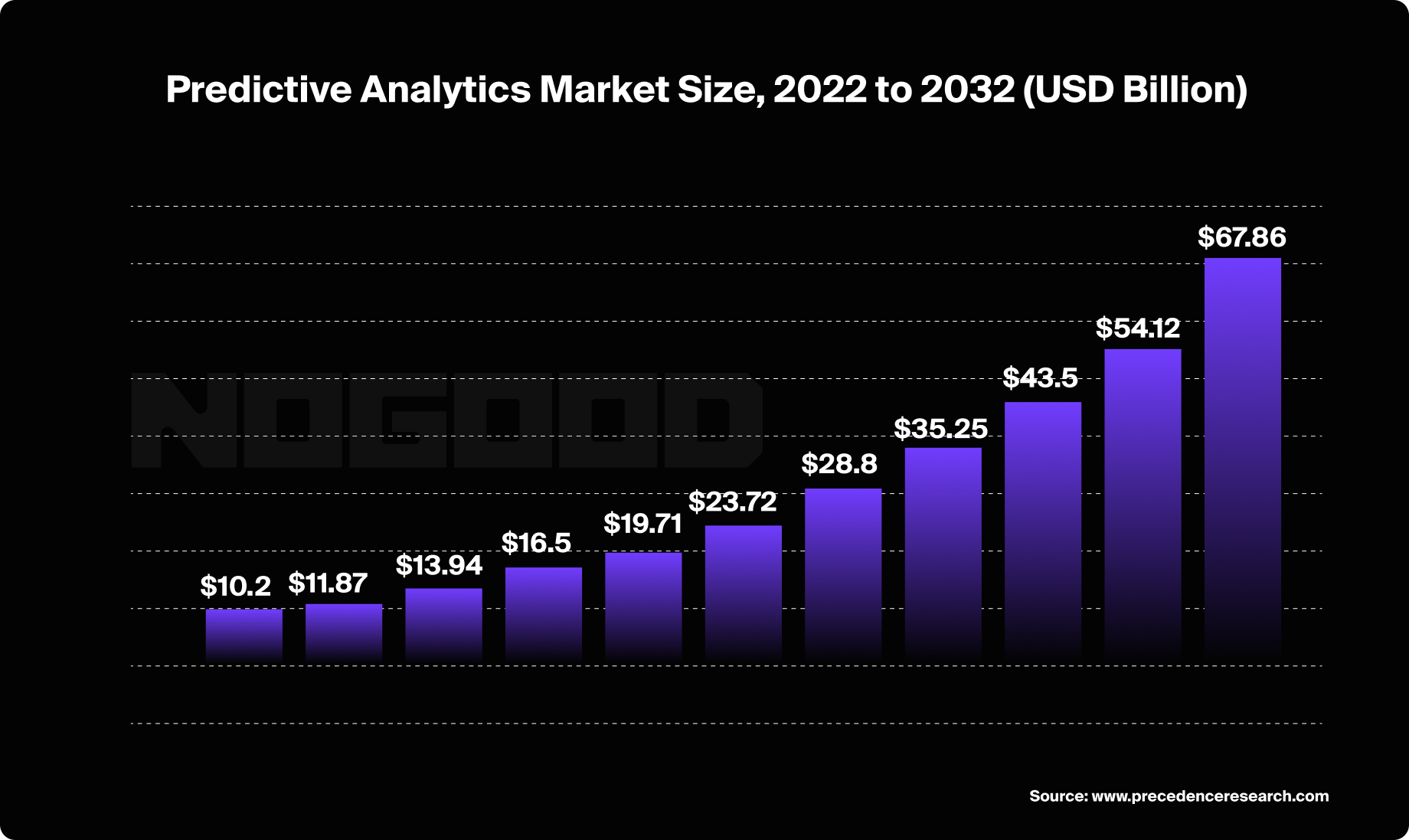
Understanding Predictive Analytics
What is Predictive Analytics?
Combined with statistical modeling, data mining techniques, and machine learning, predictive analytics works to determine the probability of future outcomes. It helps make predictions about future events, trends, and behaviors to support decision-making and strategic planning. Predictive analytics is widely used in marketing for segmenting, targeting, acquiring, and retaining customers, for determining what kinds of ads show and which would be most effective.
For example, a user arrives on your site through your Meta ads acquisition campaign. What are the chances that this user will click to sign up on the bottom part of your page? Predictive analytics can tell you exactly that.
Key Components & Technologies
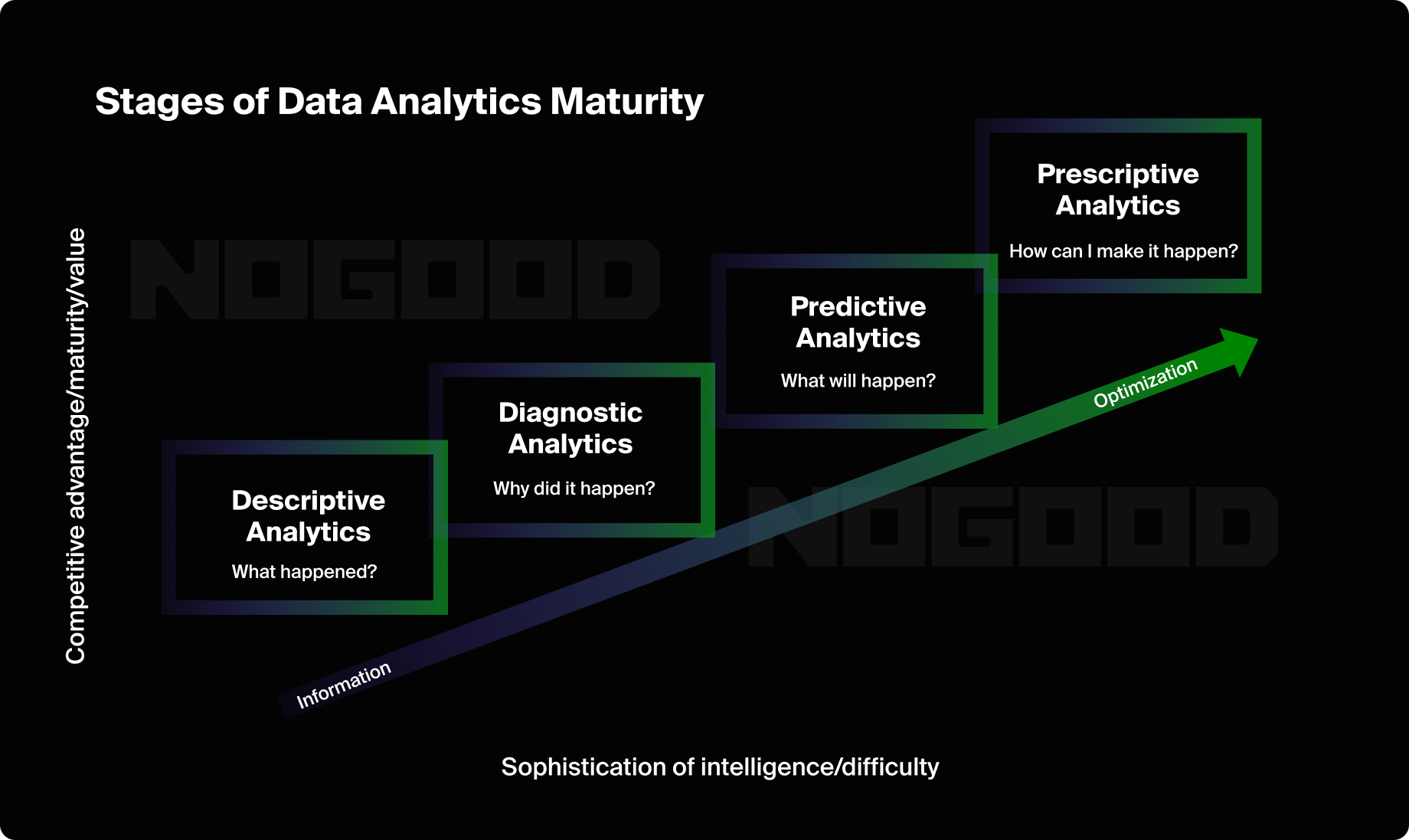
Companies make significant decisions based on their data. To make better decisions, a lot of times, companies don’t need more data but rather better data. This includes better hygiene, discipline and insights. As they progress in their understanding and use of their data, they go through the maturity model mapping the data analytics journey and stages. Each maturity step, outlines a particular value in transforming raw data into actionable insights.
- Descriptive Analytics: This is the first phase. Descriptive analysis plays an important role in summarizing past and current marketing performance. It answers basic questions such as “What happened?” by providing insights into campaign performance, customer churn rates, customer retention metrics, and other key performance indicators (KPIs).
- Diagnostic Analytics: Diagnostic analytics dig deeper into asking the “Why did it happen?” question. They go a level deeper than descriptive analytics, focusing on understanding if the outcome should have been expected or not, and why not. This stage evaluates all the factors of why something happened the way it did.
- Predictive Analytics: Predictive analytics builds on the insights gained from descriptive and diagnostic analyses. Questions on this stage are proactive focusing on what’s likely to happen next. At this stage, the maturity model transitions to a forward-looking perspective, moving from a reactive approach to a more proactive mode. On this step, marketers are able to answer crucial questions such as “What is likely to happen next?” by predicting, for example, the risk of customer churn, campaign response rates, or future market trends.
- Prescriptive Analytics: At this stage, the goal is to focus on the decisions that can be made to influence the future. The goal is to find the best course of action for a given situation. Prescriptive analytics answers the critical question, “What should we do?” by providing specific, data-driven recommendations. Example questions that prescriptive analytics can answer include “How would having more sales reps affect our conversion rate?” and “How would adjusting our marketing strategy to focus more on influencer marketing affect the expected revenue next month?”.
Benefits of Predictive Analytics in Marketing
Hyper-Personalization
Companies are using predictive analytics through real-time data to create highly personalized experiences for their customers. This leads to higher performance of marketing efforts as users react positively to personalized content vs general content as it touches on their own needs.
An example of hyper-personalized journeys was when Gucci teamed up with Snapchat in 2020 to launch an augmented-reality campaign to try on shoes. This involved creating a virtual lens that superimposed a digital version of the shoe on the shopper’s foot when it was photographed with a phone camera, and the color of the shoe would be suited based on the user’s color preferences.
Along with the “Shop Now” button that directed customers to the online store, Gucci reached 18.9 million Snapchat users and reported a positive return on ad spend. Since then, Gucci has aired multiple other efforts, such as the try on Rouge de Beauté, signaling that these type of experiences yield positive results for the brand.
Accurate Trend Prediction
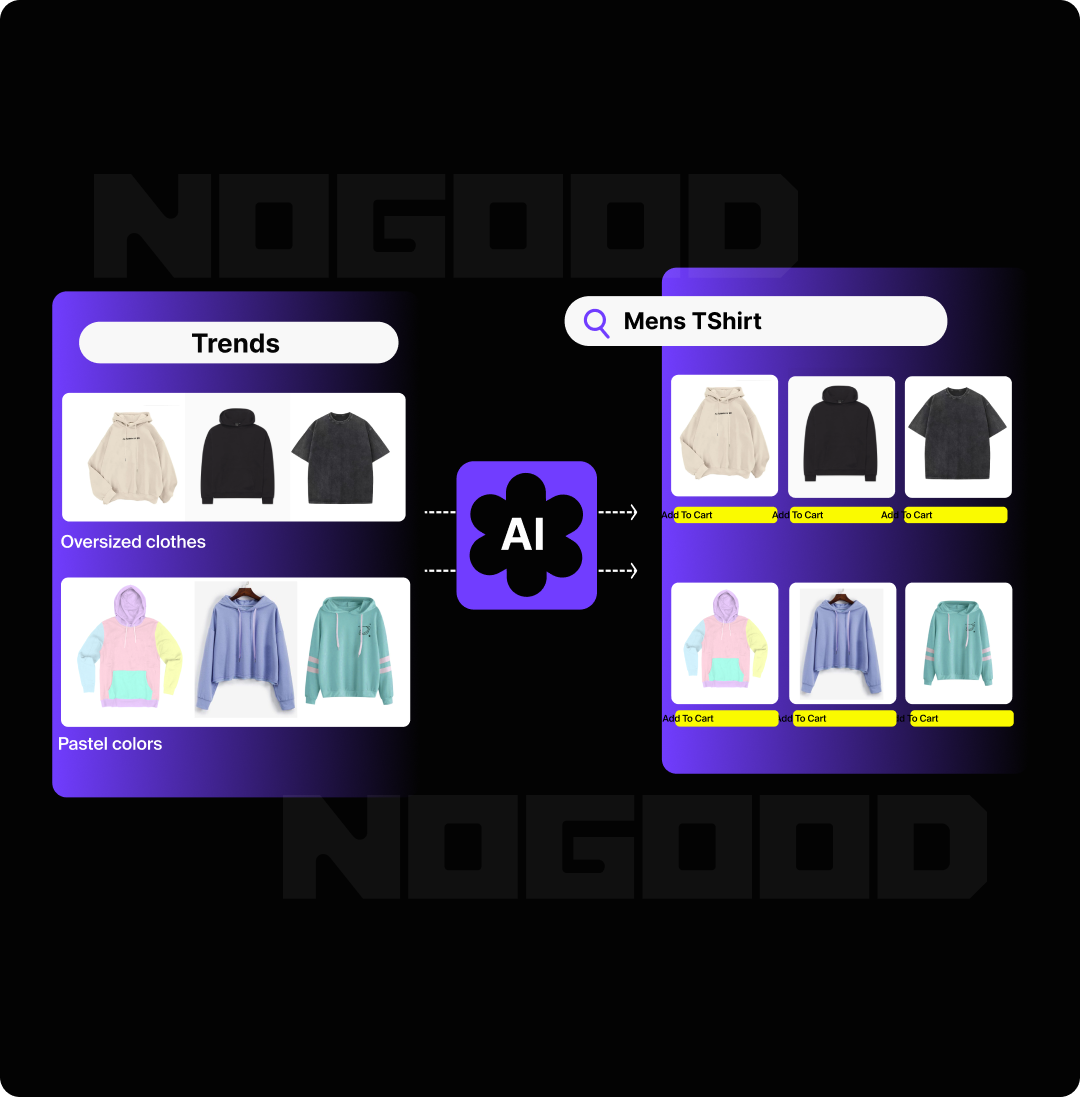
Predictive analytics use historical and real-time data to accurately predict customers’ needs. That way, companies can identify instant growth opportunities by prioritizing what’s important to their customers. Do you usually buy new pairs of shoes for summer around April throughout the last few years? Companies have data on that, and they’ll make sure to advertise the type of shoes that you usually buy when the time for you to buy new shoes comes next season.
Netflix is a great example of using trend predictions to increase their platform usage. They take feedback from every visit to Netflix (for example, which titles you start watching) and continually update their algorithms with different types of signals to improve the accuracy of their prediction of what users are most likely to watch.
Intelligent Customer Segmentation
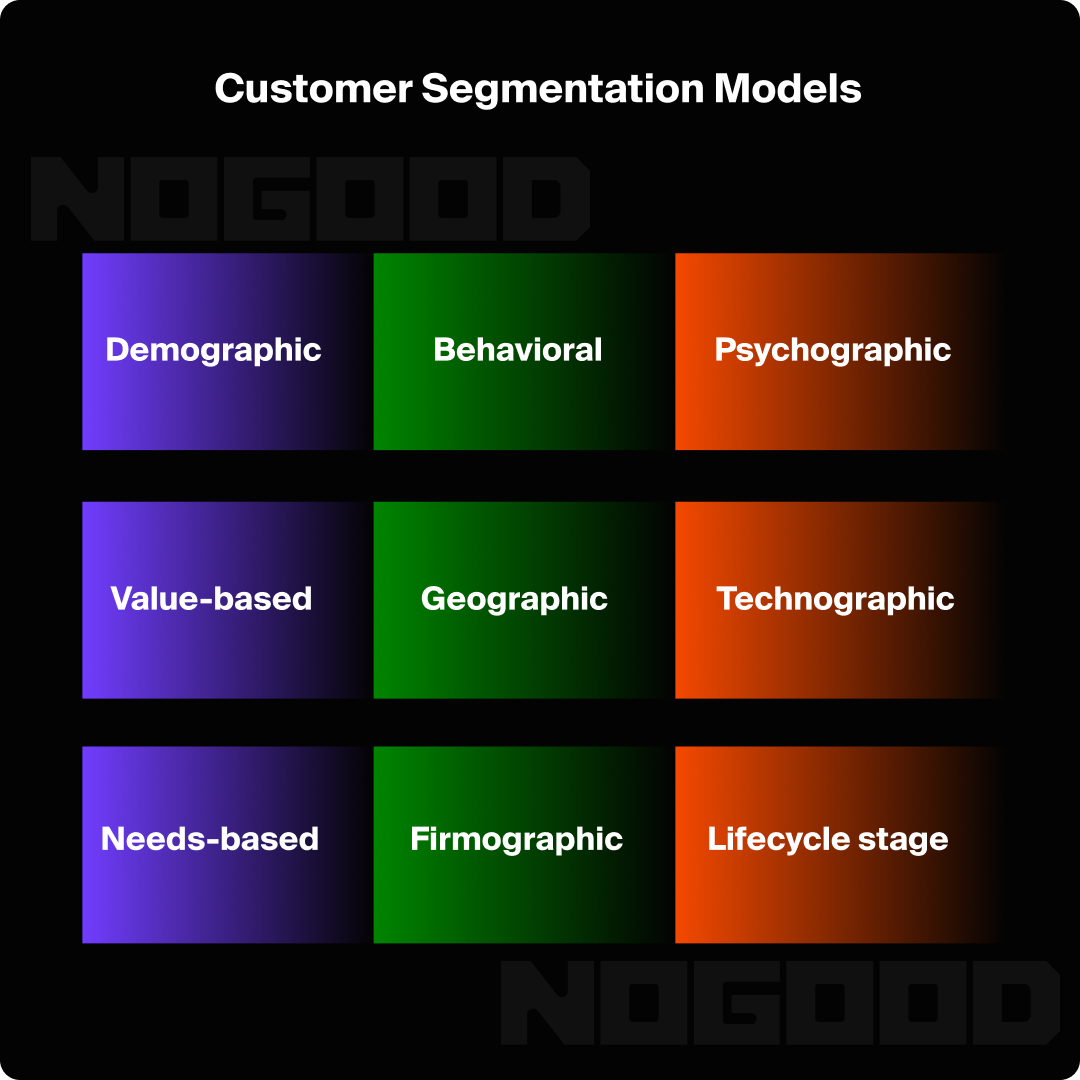
Customer segmentation splits your entire customer base into smaller segments based on shared characteristics including demographic, behavioral, geographical, and other types of data. Through customer segmentation, companies can better understand users’ needs and adjust offerings instantly to satisfy their needs.
Companies that use loyalty programs use the information provided by their customers to predict future behaviors. Such is what the customer is going to buy next. Sephora is an example where they use purchase, browsing, and other types of user behavior to then create targeted marketing campaigns.
This also results in improved customer loyalty and retention. Were you just looking at that specific perfume a few days ago when you “accidentally” came across a few days later on an Instagram campaign showing you an offer for that perfume? This is a result of Sephora’s marketers doing their job pretty well.
Efficient Lead Prioritization
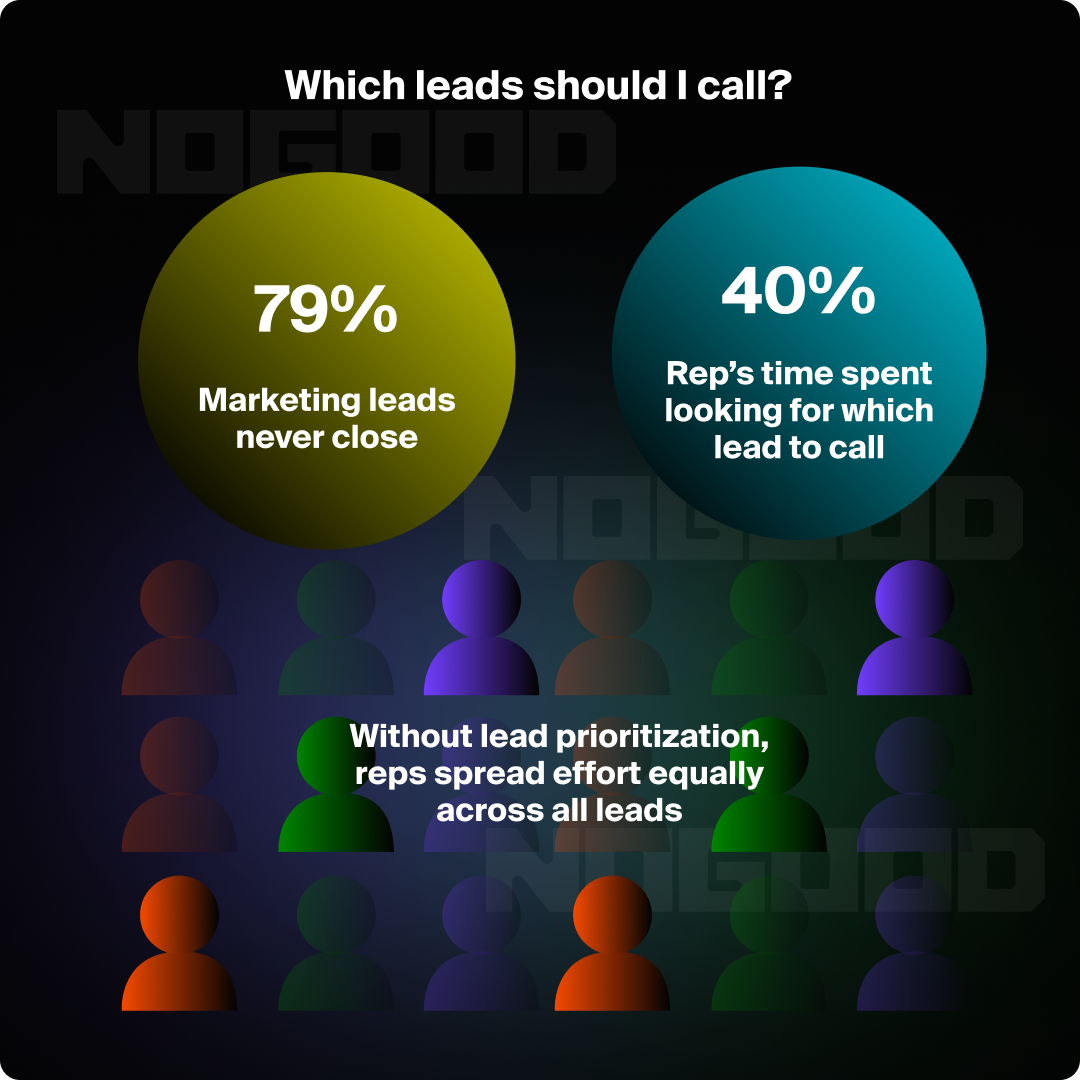
Lead scoring measures the potential value. Through lead scoring, companies can rank and prioritize leads objectively by considering certain engagement-level factors and above. By focusing on high-potential prospects, marketers can increase conversion rates and improve the efficiency of their sales efforts.
Most B2B companies, including Salesforce, use predictive lead scoring to evaluate potential customers according to their likelihood of conversion. The sales teams focus on leads with a high hit rate, improving their conversion rates and overall sales productivity.
Effective Campaign Modeling
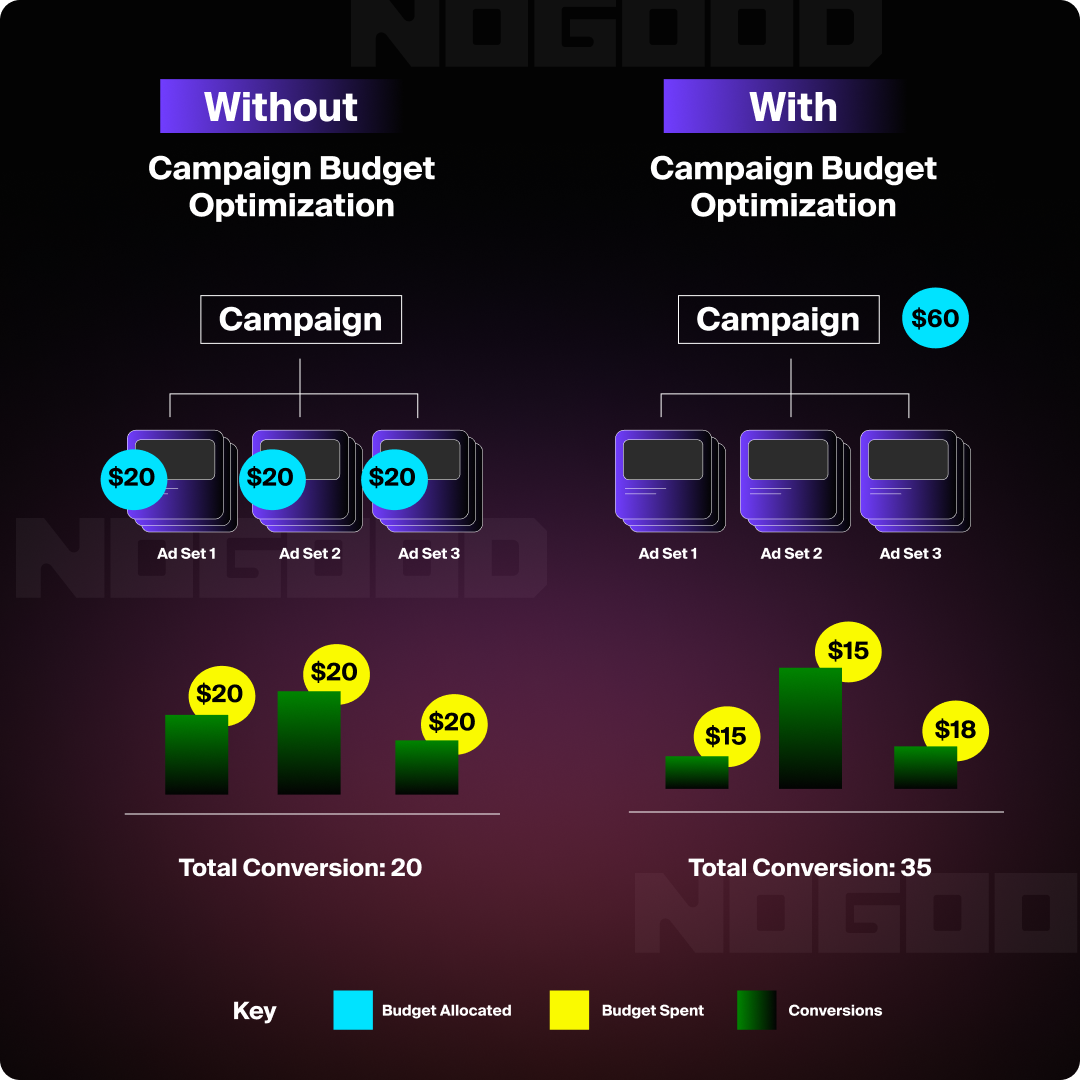
Predictive analytics can analyze past campaign performance and other external factors. Through predictive analytics, marketers can predict multiple things that can increase their campaign performance, including the exact timing (day and time) that they would need to increase their budget for a specific campaign or channel.
An example of this is when Tesla launched their Model 3 car. They leveraged predictive analytics and customer segmentation to predict which users would engage more with which specific features of the car and tailored their messaging and marketing approach based on that. As a result, they increased sales significantly.
Improved Personalization of Customer Experience
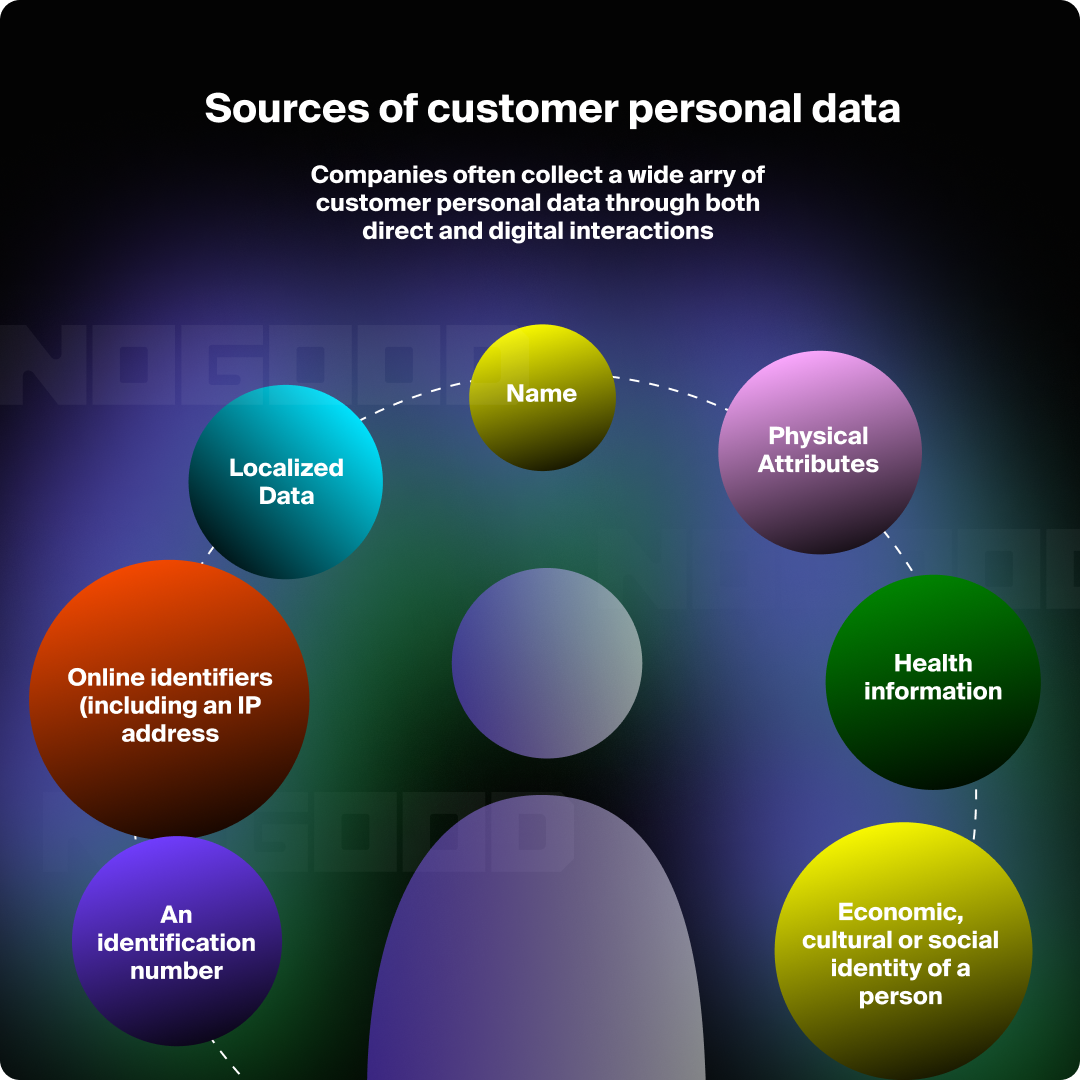
At the core of predictive analytics lies the personalization of customer experiences which helps with user engagement, increasing loyalty and sales. There are a bunch of different live data that predictive analytics has access to and can use to predict and tailor customer experiences.
As an example, Nike uses data from its acquired companies, like Fitbit, as well as their parent company data to understand customer behavior and personalize their customers’ experience. Either that’s about improving the content on their Nike app, or managing their inventory, through predictive analytics, Nike is able to be efficient in its marketing and operations activities.
Streamlined Churn Prediction
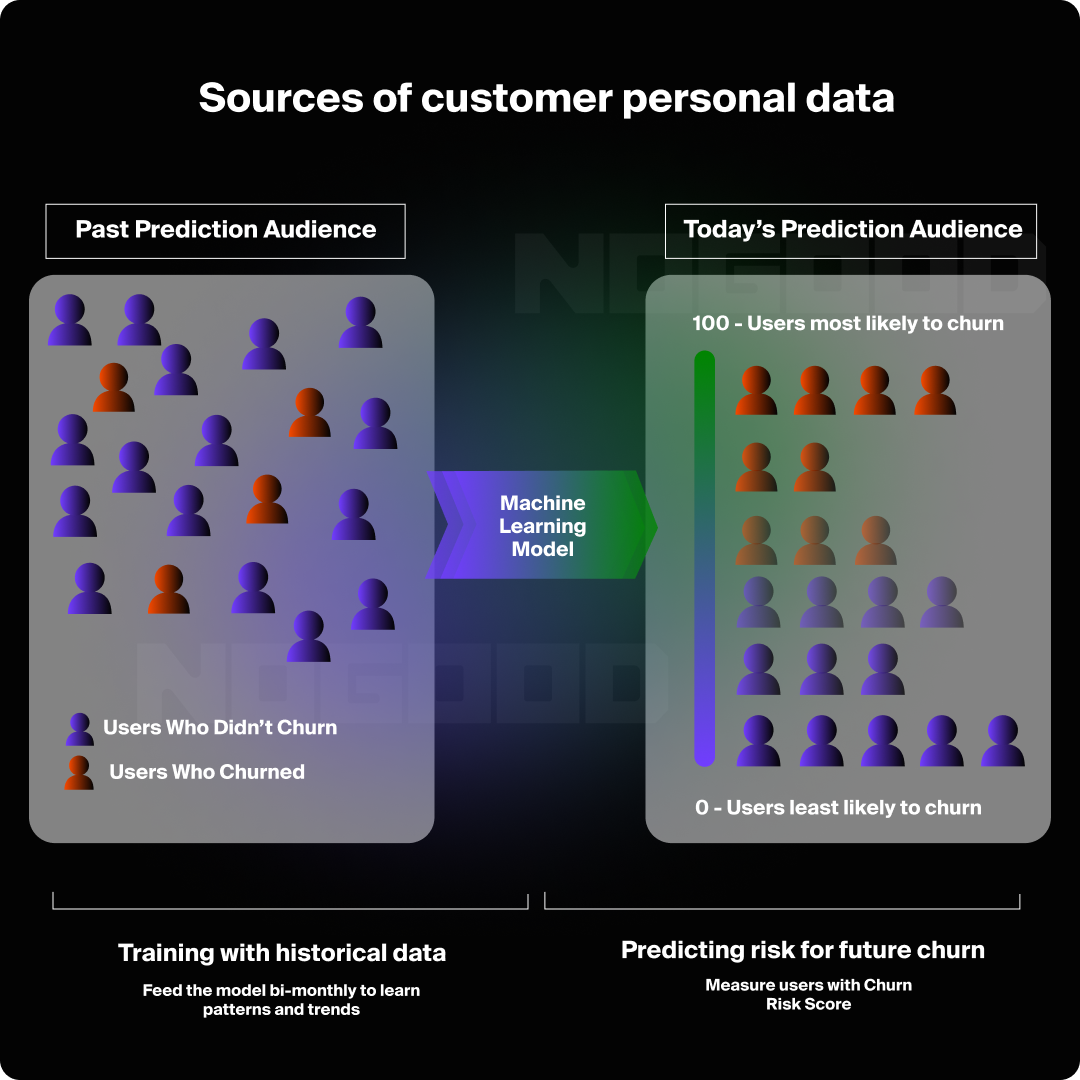
Predictive analytics can be used to predict customer churn. By making sure that companies use predictive analytics to identify at-risk customers, they are able to be proactive and take certain actions in order to improve their customer loyalty before it’s too late.
Hydrant, a beverage company, implemented a predictive churn model to identify at-risk customers. They used purchase history and customer behavior and assigned churn scores. Marketing efforts were then targeted to those “at-risk” customers. As a result, they saw a 2.6x increase in conversion rate and a 3.1x higher average revenue per customer.
The Core Types of Predictive Analytics Models in Marketing
At the heart of predictive analytics are four basic model types: Classification, Clustering, Time Series, and Outlier Detection. Each model serves a specific purpose and offers distinct advantages to marketing initiatives by uncovering insights hidden in the data.
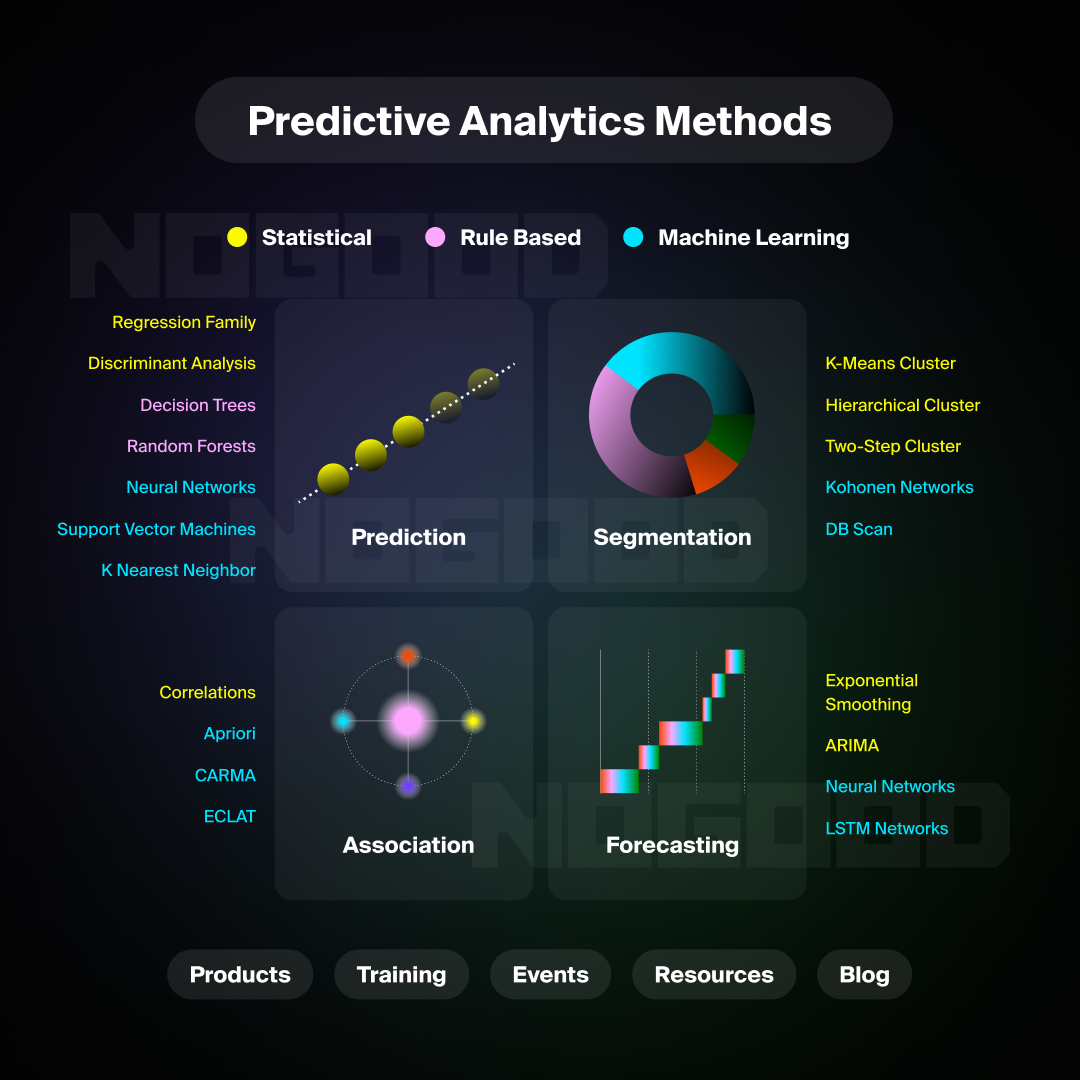
Classification Models
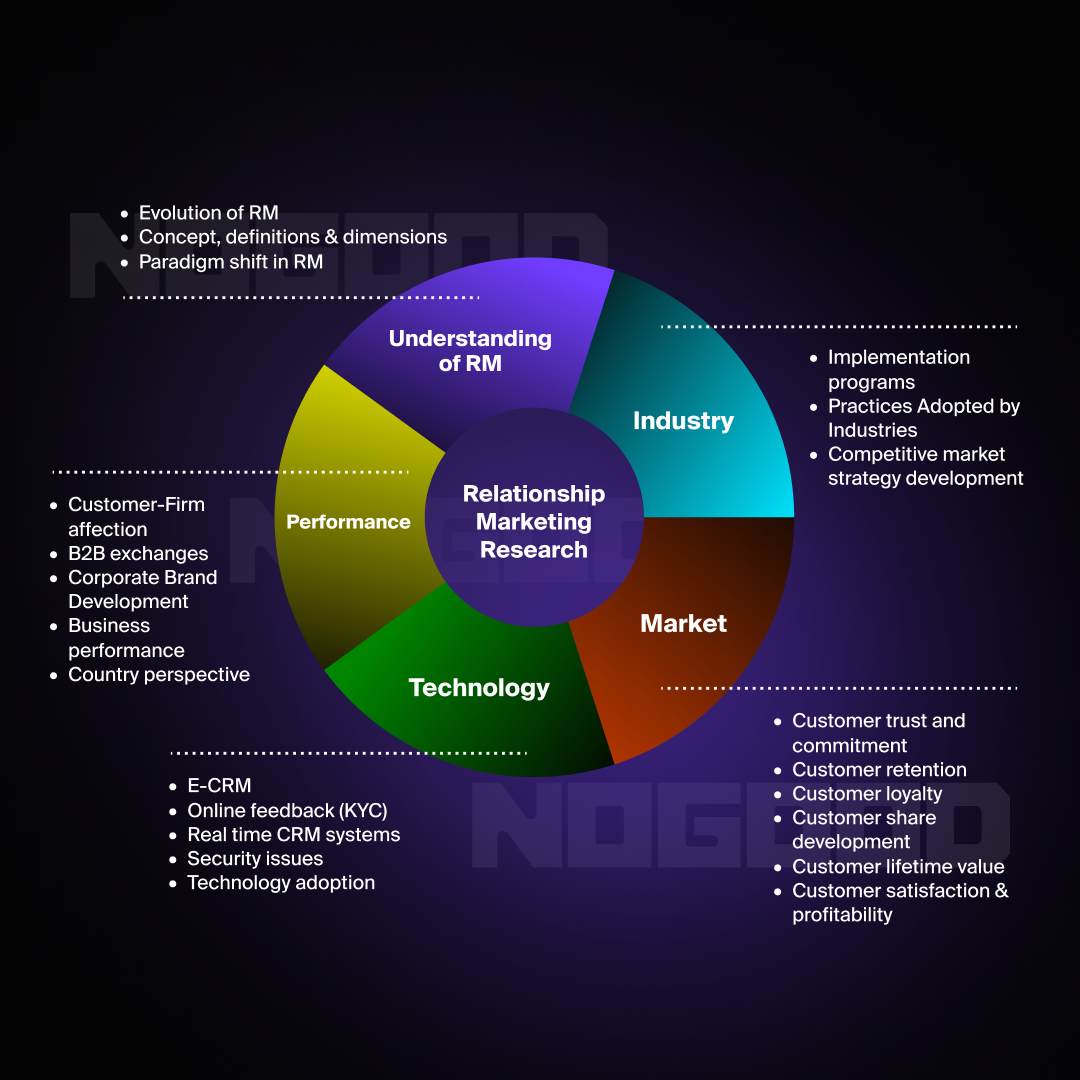
Classification models fall under supervised machine learning models. These models categorize data based on historical data and describe the relationships within a particular data set. This model can be used, for example, to categorize customers or prospects into groups for segmentation purposes. Alternatively, it can also be used to answer “yes” or “no” questions. A popular use case for this is fraud detection and credit risk assessment. Types of classification models include logistic regression, decision trees, random forest, neural networks, and Naïve Bayes.
Clustering Models
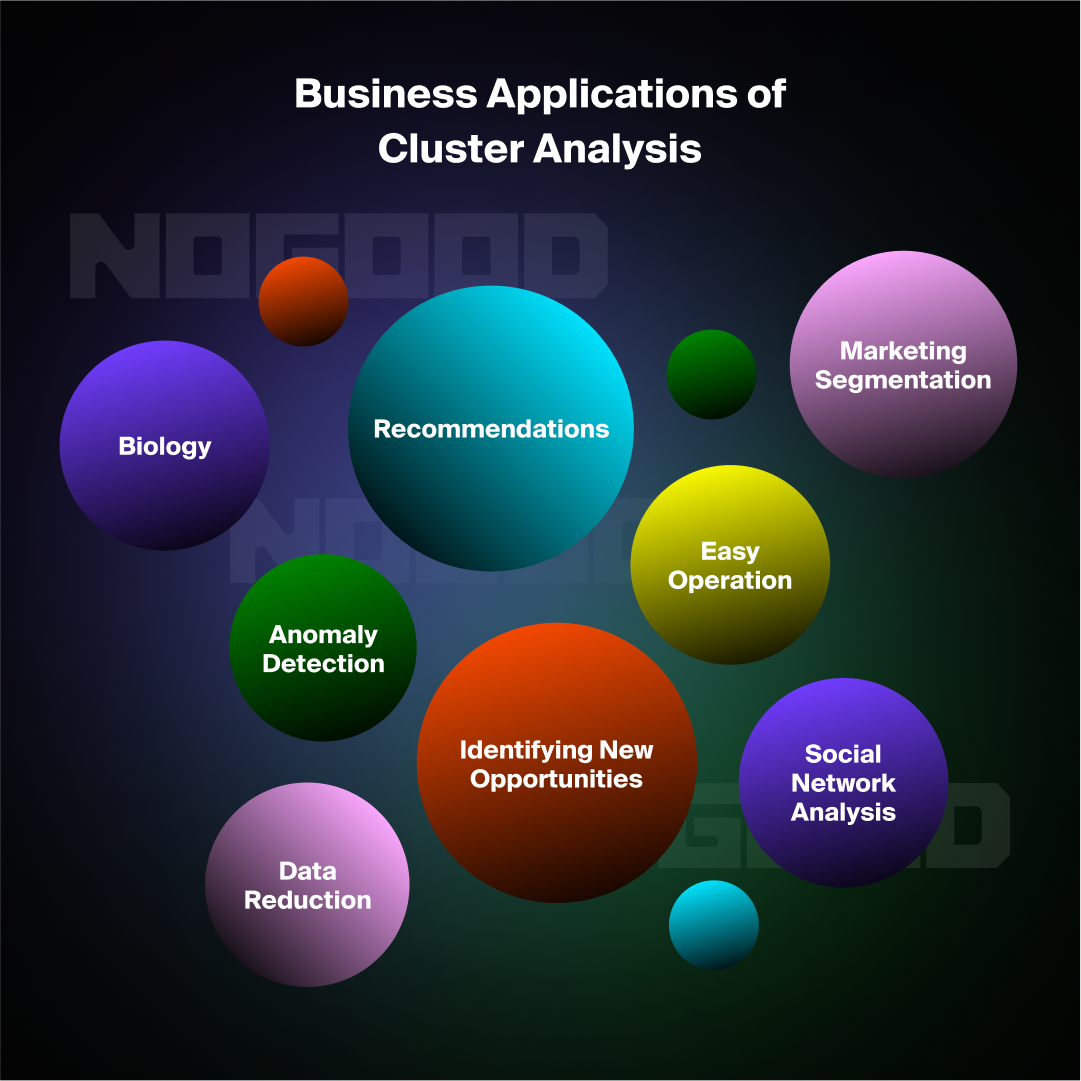
Clustering models group data based on similar attributes. They fall under the branch of supervised machine learning models. For example, marketers can segment a potential customer base based on common characteristics and develop marketing strategies based on each group. Each data point is assigned to one of two data clusters using hard clustering.
When data is assigned to a cluster, soft clustering assigns it a probability. Common clustering algorithms include k-means clustering, mean-shift clustering, density-based spatial clustering of applications with noise (DBSCAN), expectation-maximization (EM) clustering using Gaussian Mixture Models (GMM), and hierarchical clustering.
Time-Series Models
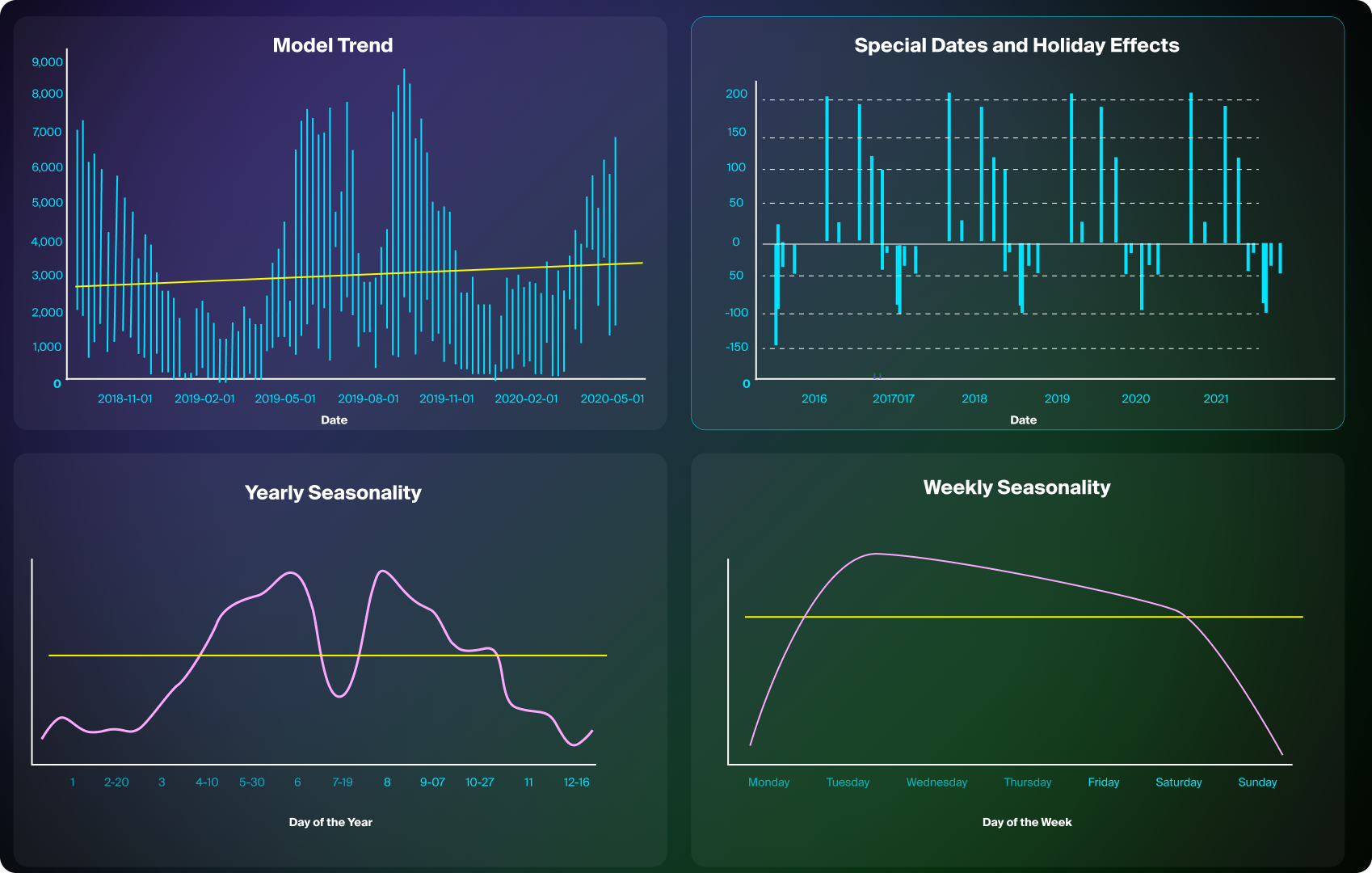
Time series use different data inputs with a specific time-frequency, such as daily, weekly, monthly, etc. The time series model develops a numerical measure predicting trends within a specific period by combining multiple data points from historical data. You can plot the dependent variable over time to examine the data for seasonality, trends, and cyclical behavior, which may then indicate the need for certain transformations and model types. Autoregressive models (AR), moving average (MA), ARMA, and ARIMA are all-time series models.
For example, an eCommerce company can use a time series model to predict how many purchases they will receive per hour at different times of the day. Another example where time-series models are put into play is for stock price analysis. Overall, in any case, if you believe past patterns will influence future trends, then time series analysis is useful.
Outlier Detection Models
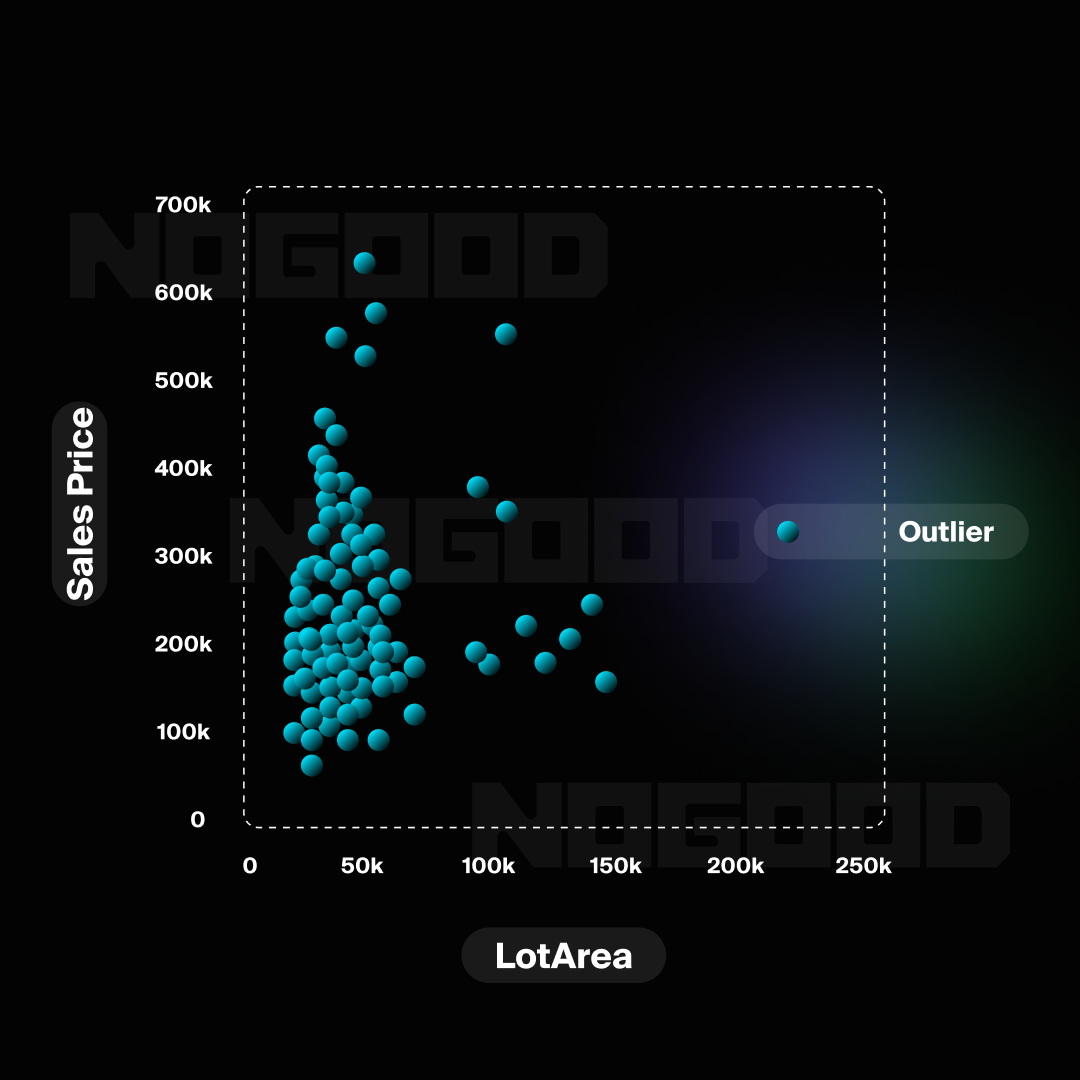
Outlier detection models identify data points that fall outside the expected range of the majority of the data. Anomalous data is data that deviates from the norm. It works by recognizing anomalous data, either alone or in conjunction with other categories and numbers.
These models are critical for detecting unusual behavior that could indicate fraud, operational issues, or new, emerging consumer trends. In marketing, outlier detection can be a critical factor in the early identification of unique opportunities or risks. For example, a sudden spike in order volume on an e-commerce site, as seen in the company’s total hourly orders, could be a contextual outlier if this high volume occurs outside of a known discount promotion or high-volume period.
Essential Data Types for Effective Predictive Analytics
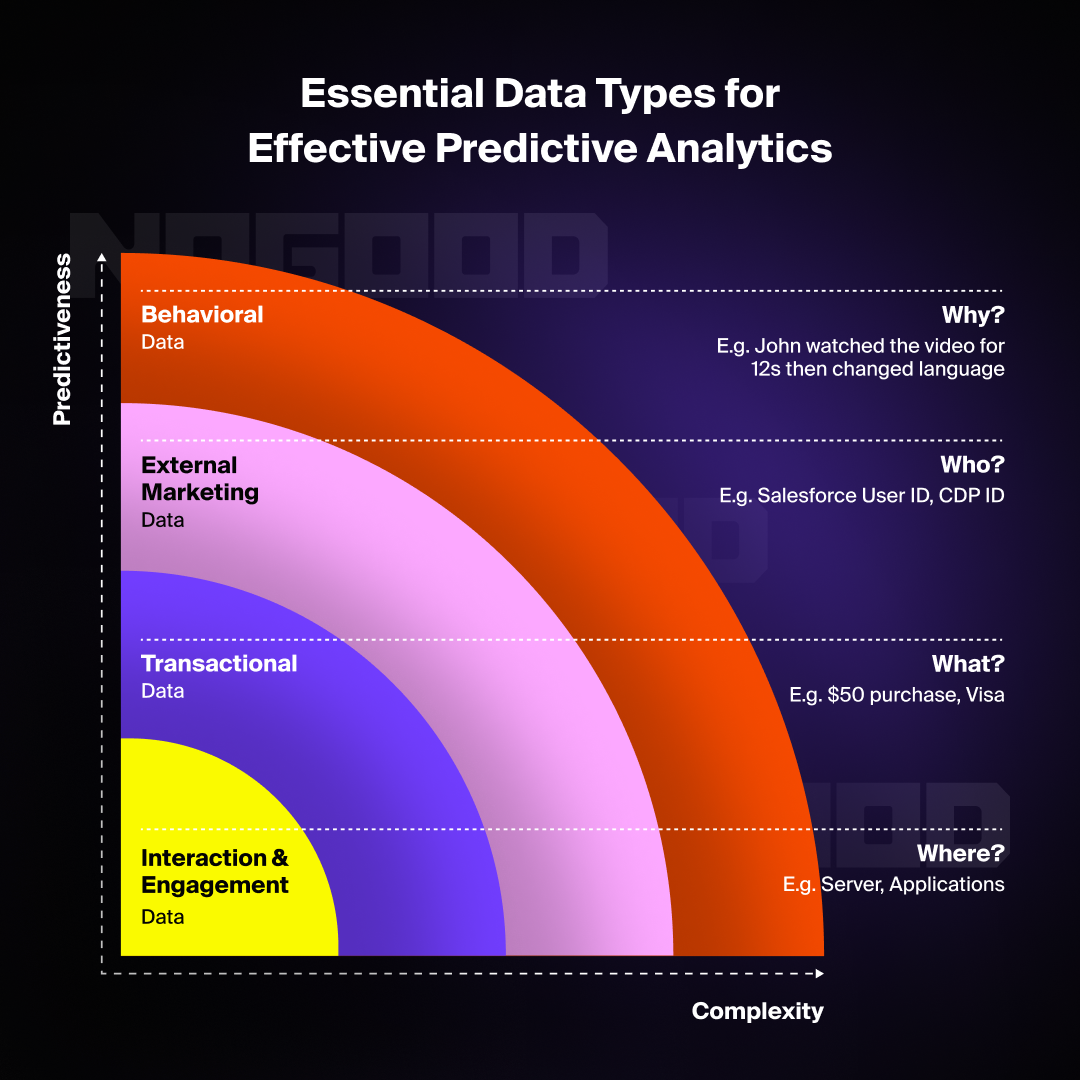
Behavioral Data
Behavioral data describes interactions with customers, partners, applications, and systems in granular detail. Richly contextual and predictive by nature, it is the best possible fuel for advanced analytics and AI applications. Examples of such data include search behavior, customer loyalty, ratings, and reviews, videos watched, and web analytics.
Demographic Data
Demographic data answer the “Who?” question. Who are the customers? Where are they from? What do they do for a living? These are all questions that demographic data can answer. Some examples of demographic data include age, income, education, race, ethnicity, or religion.
Transactional Data
Transactional data provide a solid foundation for predicting future customer transactional behavior. This type of data can be used for upsells or cross-sells. Such data include purchase history, transaction amounts, purchase frequency, product popularity, refunds, and returns or churn rates.
Systems Data
Systems data refers to the information generated by and related to the operation of computer systems and applications. This data can be collected from various sources within the IT infrastructure like from servers, applications, databases, network devices, or operating systems.
Building A Simple Predictive Model
If you’re new to predictive modeling in marketing, you should start with something familiar. It’s probably best to choose a smaller sample that is relatively easy to study. Here is a step-by-step guide to creating a simple time series model using a spreadsheet:
- Step 1: In an Excel worksheet, enter two data series that correspond to each other: 1) A series with date or time entries for the timeline and 2) A series with corresponding values. These values will be used to predict values for future dates.
- Step 2: Select both data series.
- Step 3: On the Data tab, in the Forecast group, click Forecast Sheet.

- Step 4: In the Create Forecast Worksheet box, select either a line chart or a bar chart for the visual representation of the forecast.
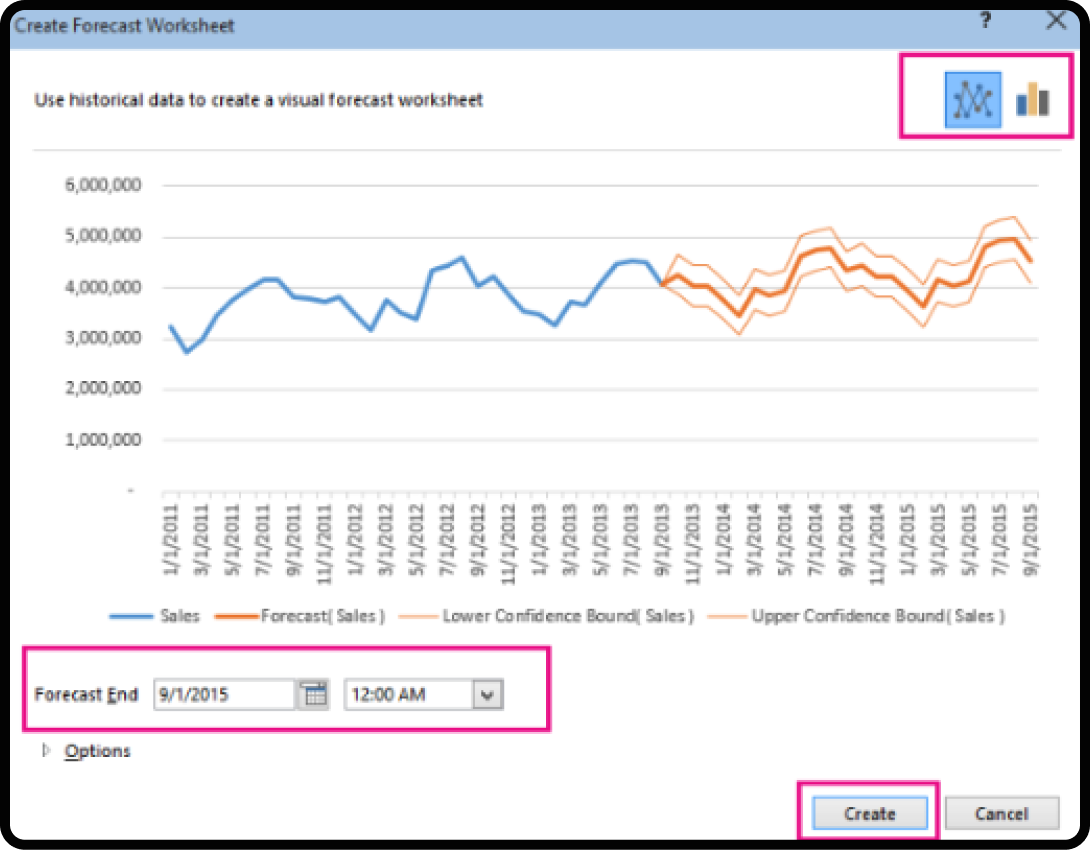
- Step 5: In the Forecast End box, select an end date and then click Create. Excel creates a new worksheet that contains both a table with the historical and forecast values and a chart in which this data is displayed. The new worksheet is located directly to the left (“in front”) of the sheet in which you entered the data series. You’re done!
Remember that the above is a very basic predictive model. However, it serves as a basic example to understand how predictive models work. Developing more complex predictive models is an interactive process that requires technical expertise. There are many tools currently available in the market that make predictive modeling for companies a much easier process than what it is.
Advanced Tools for Predictive Analytics in Marketing
Pecan AI
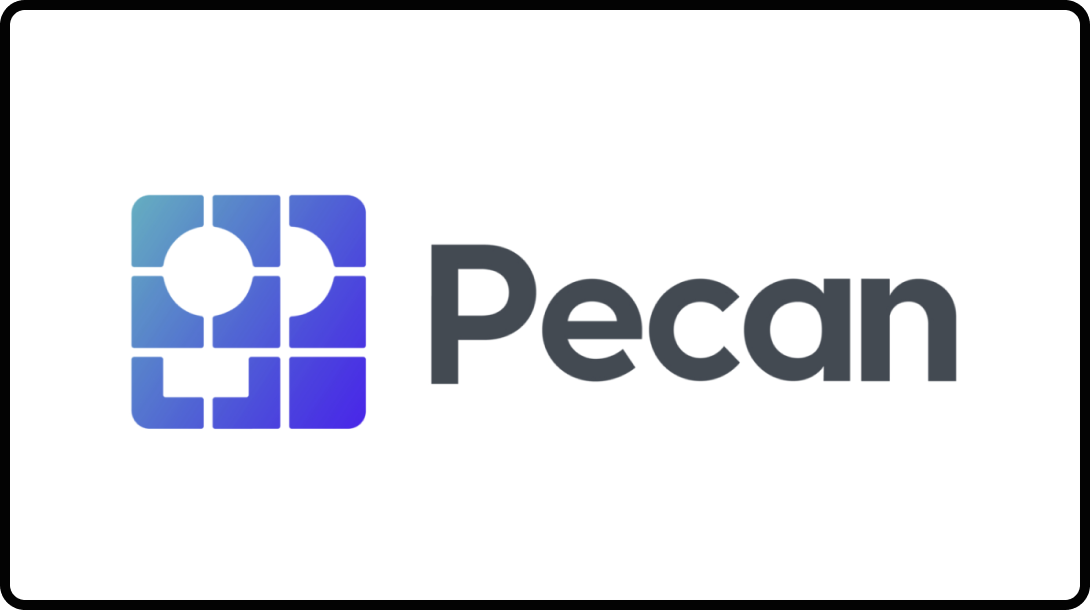
Pecan’s Predictive GenAI is a user-friendly, data science platform that allows to build AI models for tasks related to predictive analytics for metrics such as customer lifetime value, churn, and response rates, bringing advanced analytics within reach for companies that can’t support or don’t want to invest in advanced technical expertise.
Segment
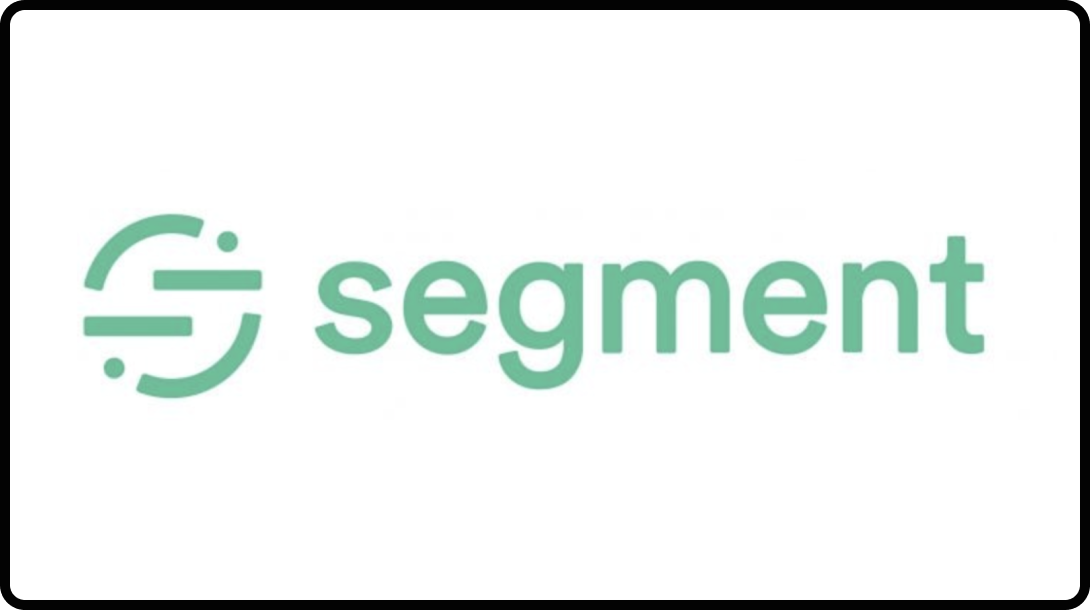
Segment is an easy-to-use customer data platform that allows marketers to seamlessly capture, cleanse, and analyze customer data. By integrating with predictive analytics tools, marketers can use predictive insights to improve targeting precision and campaign effectiveness.
Google Analytics 4 (GA4)
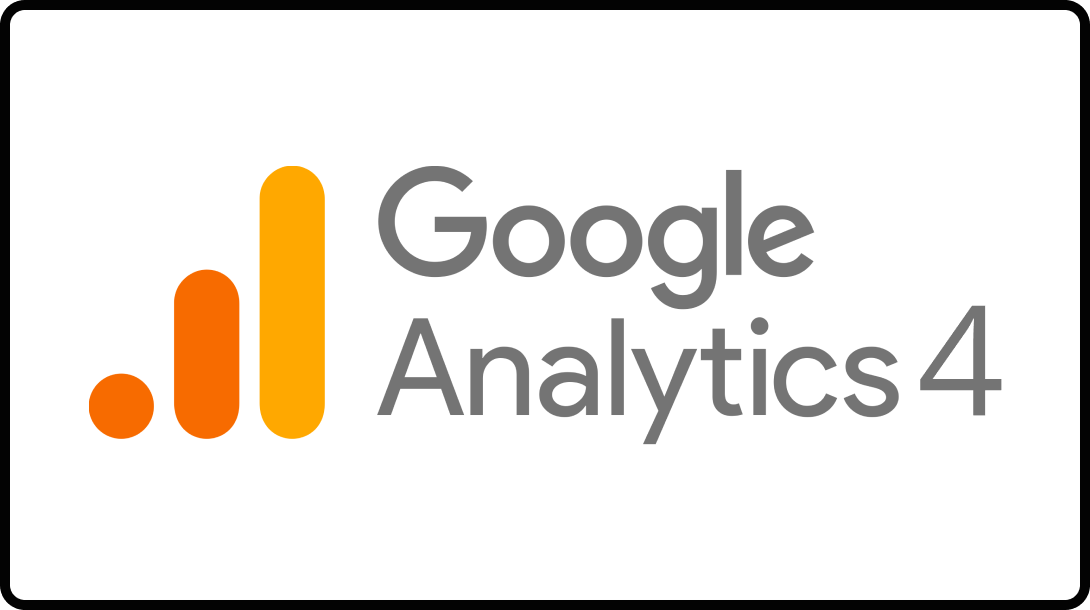
GA4 leverages machine learning to examine data patterns, fill in gaps in user data, and forecast future actions. It enhances data automatically and offers predictive metrics like purchase probability, churn probability, and estimated revenue. Though GA4 may not be perfect for long-term forecasts, it offers useful short-term insights to refine campaigns based on user behavior. Plus, it’s free.
Voyantis
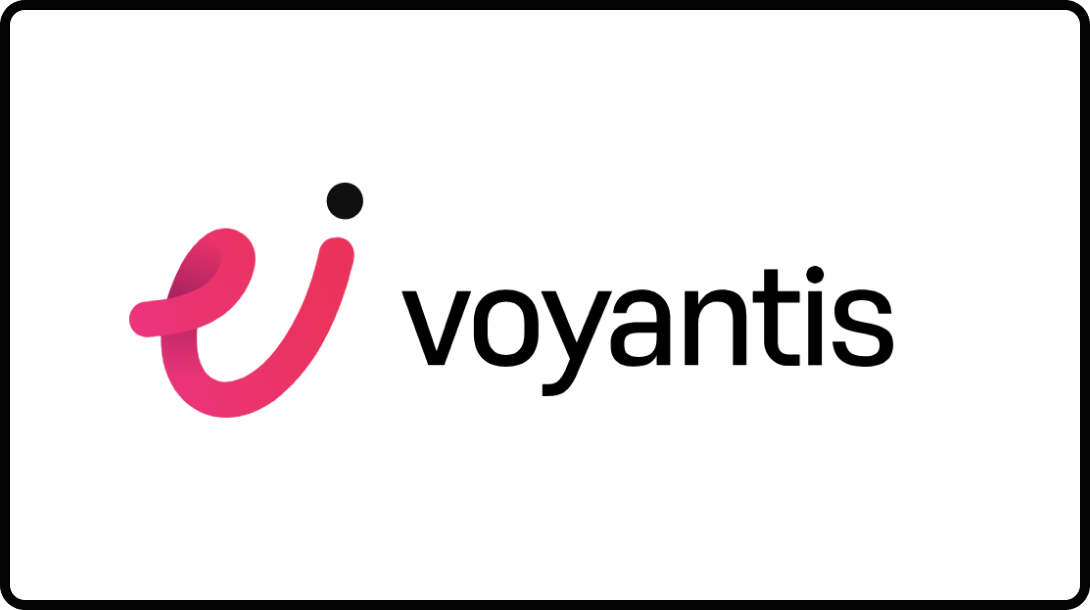
Each Voyantis model is unique. It offers customized solutions for companies looking to optimize their marketing strategies. Integrating directly with tools such as Meta ads and Google ads, their AI learns your core business objective and historical customer behavior, creating custom models to predict Customer Lifetime Value (LTV), helping you acquire the most profitable audiences.
Adobe Analytics
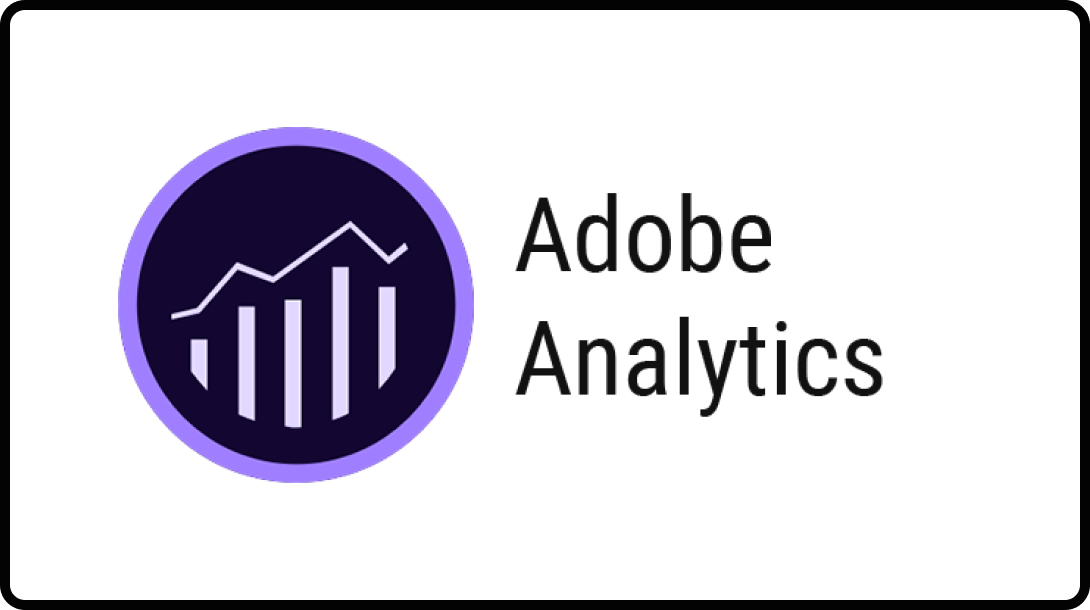
Adobe Analytics provides real-time analysis and in-depth insights into the customer journey. Its predictive features include anomaly detection and contribution analysis, enabling marketers to spot unexpected trend shifts and understand the reasons behind these changes.
IBM Watson
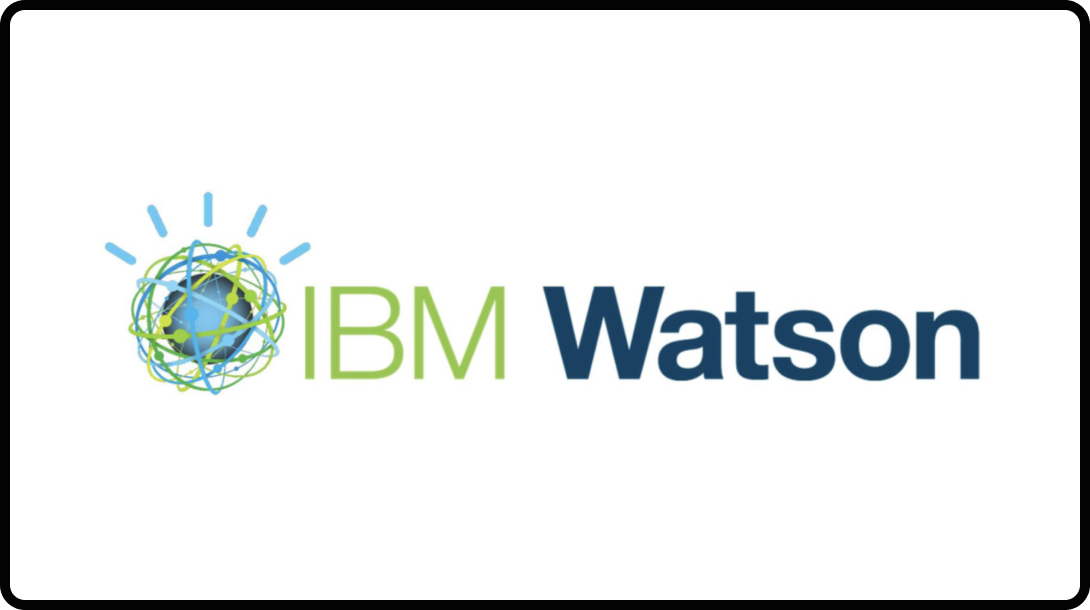
IBM® watsonx.ai™ AI studio is integrated into the IBM watsonx™ AI and data platform, combining next-gen AI features driven by foundation models and traditional machine learning into a comprehensive studio covering the entire AI lifecycle. Use your enterprise data to fine-tune and steer models with user-friendly tools designed for creating and refining effective prompts. With watsonx.ai, AI applications can be developed much faster and with significantly less data.
SAS Marketing Automation
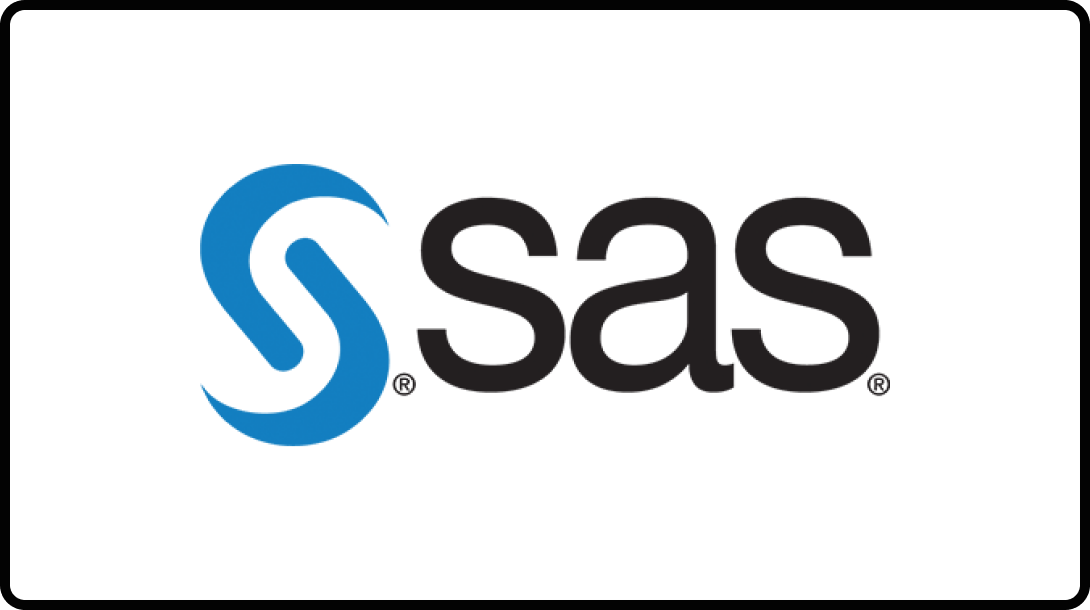
SAS is a leading tool for statistical and data analysis. Its extensive software suite handles data management, data mining, report creation, and more. It’s utilized to find answers to analytical questions, automate decision-making, and uncover new technologies through predictive analytics and machine learning.
The Future of Marketing with Predictive Analytics
Modern algorithms now allow businesses to foresee consumer desires with remarkable precision. Experts suggest that by 2025, nearly all customer interactions, including phone and online conversations, will be driven by AI, making it difficult for customers to identify bots. The integration of data science and AI is essential in contemporary marketing, enhancing our ability to forecast market trends and reshaping our comprehension and influence on customer behavior.
Utilizing data science and AI, businesses can initiate a new phase of marketing efficiency, fostering stronger customer relationships, greater marketing returns, and enduring success.






